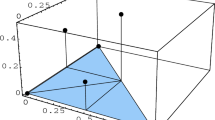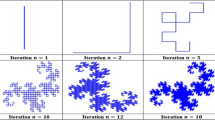Abstract
We consider cryptographic properties of parastrophic quasigroup transformation defined elsewhere. Using this transformation we classify the quasigroups of order 4 into three classes: 1) parastrophic fractal; 2) fractal and parastrophic non-fractal; and 3) non-fractal. We investigate the algebraic properties of above classes and present a relationship between fractal and algebraic properties of quasigroups of order 4. We also find a number of different parastrophes of each quasigroup of order 4 and use it to divide the set of all quasigroups of order 4 into four classes. Using these classifications the number of quasigroups of order 4 which are suitable for designing of cryptographic primitives is increased compared to the case where parastrophes are not used.
Access this chapter
Tax calculation will be finalised at checkout
Purchases are for personal use only
Preview
Unable to display preview. Download preview PDF.
Similar content being viewed by others
References
Bakeva, V., Dimitrova, V.: Some Probabilistic Properties of Quasigroup Processed Strings useful in Cryptanalysis. In: Gusev, M., Mitrevski, P. (eds.) ICT Innovations 2010. CCIS, vol. 83, pp. 61–70. Springer, Heidelberg (2011)
Bakeva, V., Dimitrova, V., Popovska-Mitrovikj, A.: Parastrophic Quasigrouop String Processing. In: Proc. of the 8th Conference on Informatics and Information Technology with International Participants, Macedonia, pp. 19–21 (2011)
Dimitrova, V., Markovski, S.: Classification of quasigroups by image patterns. In: Proc. of the Fifth International Conference for Informatics and Information Technology, Macedonia, pp. 152–160 (2007)
Krapež, A.: An Application of Quasigroups in Cryptology. Math. Maced. 8, 47–52 (2010)
Markovski, S., Gligoroski, D., Bakeva, V.: Quasigrouop string processing: Part 1. Contributions. Sec. Math. Tech. Sci., MANU XX(1-2), 13–28 (1999)
Markovski, S., Dimitrova, V., Samardziska, S.: Identities sieves for quasigroups. Quasigroups and Related Systems 18(2), 149–164 (2010)
Denes, J., Keedwell, A.D.: Latin Squares and their Applications. The English Universities Press Ltd. (1974)
Author information
Authors and Affiliations
Corresponding author
Editor information
Editors and Affiliations
Rights and permissions
Copyright information
© 2013 Springer-Verlag Berlin Heidelberg
About this paper
Cite this paper
Dimitrova, V., Bakeva, V., Popovska-Mitrovikj, A., Krapež, A. (2013). Cryptographic Properties of Parastrophic Quasigroup Transformation. In: Markovski, S., Gusev, M. (eds) ICT Innovations 2012. ICT Innovations 2012. Advances in Intelligent Systems and Computing, vol 207. Springer, Berlin, Heidelberg. https://doi.org/10.1007/978-3-642-37169-1_23
Download citation
DOI: https://doi.org/10.1007/978-3-642-37169-1_23
Publisher Name: Springer, Berlin, Heidelberg
Print ISBN: 978-3-642-37168-4
Online ISBN: 978-3-642-37169-1
eBook Packages: EngineeringEngineering (R0)




